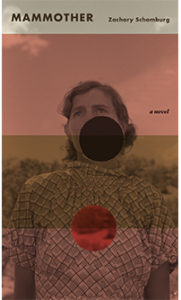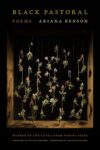 [Featherproof Books; 2017]
[Featherproof Books; 2017]
TEN FRAGMENTS ON MAMMOTHER
- More poets should write novels. That’s what I’m thinking after reading Zachary Schomburg’s Mammother. Or maybe it’s not that. Maybe it’s that the definition of a poet has more to do with a way of seeing than whatever form the writing that follows such seeing takes. I’ve been thinking of this lately, perhaps because it is one of the great pastimes of the poet to discuss the worth of the poet. But I think the aim of the poet is tied to the aim of the artist: to remember, to tell, and in such telling, to reinvent. As Hilton Als writes: “Artists remember the world as it is, first, because you have to know what it is you’re reinventing.” It’s clear, then, that Schomburg remembers well. And out of such remembrance, he has crafted out of his novel a space of fabulist, sentiment-rich time. Like Marquez’s best work, Mammother takes its reader down the soil-rich lineage of communal mythology. Like Shane Jones’ beautiful and tender Lightboxes, Mammother narrows its focus to one place, one town, and the ways in which small gatherings of people reacting to change reflect how all of us together react to the problems of time. But to compare such a novel to other lessons in fabulism is to deny that odd things happen in all places. At some point in your life, something will fall in front of your feet that you did not expect. There’s a challenge that Mammother offers the reader: to believe, simply, in what you are about to read, and then to risk reading it.
- I’m writing this while on a bus to Boston. Through the process of reading Mammother, I’ve attended one funeral – for my friend’s father – and am now on my way to visit my girlfriend’s aunt, who is in hospice care. I’ve never met her. When Meg received the news of her aunt’s potential passing, she left New York almost immediately. I offered to come up the next day for support and was taken aback when Meg said that she’d like me to meet her aunt, who, she said, always wanted to meet me. So here I am, somewhere in Connecticut, where the sky forever seems like winter, racing the timespan of a life to meet that same life at its end. I don’t know how we do this, or why. These are difficult questions. Outside my window, birds alight into the dark green mass of trees before ascending, sometimes all at once, a great dark swirl, sometimes just one, lonely or free or both.
- Mammother tells the story of a town, Pie Time, and a person, Mano Medium. The town is struck by a plague of sorts. People die, leaving behind a hole in their chest and a thing – an object, a token – placed within the hole. There is no pattern. The town has people named after their professions: The Barber, The Butcher, The Shoveler, and more. More people die. They each leave a thing. Mano grows up wearing dresses, working at a cigarette factory. He later gets a haircut and falls in love with a boy. More people die. Mano becomes a barber. Mano begins to gather all the things that the dead leave behind. He gives lessons about death to others. A widow, Inez, falls in love with him. As does a girl, Enid. Mano loves the boy more. There is a black square in his barbershop that he can move into, a new world or the same. There is a tree in a forest that people used to go to in order to be killed, to die. There is a river, The Cure, upon which the bodies are floated down when they are dead. Mano becomes bigger and bigger as he gathers the things that are left behind or given to him. There is so much and so much death. The heart of the novel thumps like a great red orb pulsing upward from the other side of the horizon as you read.
- On buses, I’m always struck by the simple fact of this box filled with people hurtling toward a fixed point while remaining still inside. Here, I am one person among many going to the same destination for, I assume, different reasons. And for a short time, we can get up within this vessel and walk around, go to the bathroom, speak or not. I never feel like I make the most of the fewer-and-far-between moments of stillness this life affords me. Schomburg has a poem in an old issue of DIAGRAM where he writes, “I told you . . . I was in fact an island and that I couldn’t join anyone anywhere.” Tell me this shouldn’t be printed underneath each window of each Greyhound hurtling down the highway.
- What is it about things, Schomburg seems to ask in Mammother. What is it about what we gather for ourselves? What is it about what we leave behind? What is it about what we refuse to let go? What is it about letting go? Does it scare us? Does it make us fear our life? Our death? Always there is that hum of Rilke from his “Archaic Torso of Apollo,” that warning, that confession and declaration: “You must change your life.”
- The bus rolls forward along 84, and we pass, in some order, a large abandoned cinema, a Burlington Coat Factory, a Sam’s Club, and an unmarked low-rise building sprawling out among the vastness of unfilled parking spaces. There is so much here, used and unused, each a kind of life, each its own kind of death. I’m afraid I don’t know how to say any more than that. In my life, I have gathered up so much. I sleep, surrounded by books and miscellany, in a room surrounded by other rooms. I save old letters. I have two big garbage bags of clothes I have yet to give away, for no reason other than the notion that there is always another day. Some nights I want to crawl through the black square that is my window and find myself surrounded by trees I cannot name, swimming in water that will never drown me, touching the hair atop another’s arm.
- At one point, Schomburg writes of Mano, “He knew his life would change if he opened the door, and he didn’t want his life to change.” At one point, Mano describes love as “a deep ache . . . Like you miss them even when you’re with them.” How can I fault a novel that searches deep enough to say such things? Why, too, do I think so much of fault? There is the tired hum in the back of my head about a line being earned or believable, but what is more deeply earned than feeling, than ache? I believe less these days in the possibility of good in art, or in any of our various abilities to sort out the goodness like gifts. I choose, more so, to believe in delight and violence and death and pulse, to believe in what skews what I know. I don’t know if I crave a distraction so much as I crave a new way of seeing, for truth, I have found, is so hard to acquire in this moment, that when I do find it, I moan audibly. I let out a sigh. I finally breathe. I turned each page of Mammother not because I felt some deep need to know what would happen, but because I felt the book a mirror, and saw the whole world looking back. In an essay Schomburg wrote for the online journal The Volta, he asserted, “Gazing will hold our attention for a very long time.” Mammother is a lesson in such gazing. We gaze into the hole that dying leaves. We gaze into the things the dying leave behind. We gaze into people and their lives and what they stuff deep inside them and what they reveal and the actions such stuffing and revealing translate to. I don’t know what we do after the gazing. I hope we are a little better for it, whatever better means.
- I don’t know what will happen when I get to Boston. I don’t know how to greet someone I’ve never met who is just about to leave this earth, what kind of pressure to apply to the hand, to offer a kiss to the forehead or the cheek. At the burial for my friend’s father, we held flowers and waited for the priest to give us permission to place them on the coffin. The plot was there. The hole was in the ground. I could, through a small space between the wood and the earth, see all the way down. It was terrifying. I had been reading Mammother on the Long Island-bound train earlier that morning and thought of Mano and his lessons about death. I thought that, if everyone in the crowd had been able to sit or stand or lie down in the earth before the burial, maybe it would make the whole thing easier. Maybe we would find it comfortable. The softness of dirt, the bits of rock lodging into the sore spots of our muscles. Maybe it would give us something to think of when we left, the same way we think of a childhood bed, or an ex-lover’s, and how we can hear the springs squeaking beneath our weight. I don’t know. It was when we left the flowers on the coffin that we cried the most. Maybe because we gave away some last thing. Maybe because we had to leave. Maybe because we felt that somewhere, still, in that coffin, was a breath of life that we were about to leave alone. Maybe because we felt, too, a little more alone. I don’t know.
- To me, the three most important words in this language are I don’t know, and they seem to be the operative words in Schomburg’s novel. I think, if I were a more cynical critic, I would find certain things at fault in the novel’s approach. There are moments in the plot that feel unnecessary or at times contrived, details that favor the poetic weight of the novel rather than forwarding some sort of narrative arc. There are also moments where you question the physics of Pie Time, and the metaphysics, too. You do this once or twice. You wonder how a body can move through a black square and into another world. And then you accept. Accept wonder. Accept joy. Sentiment. Invention. Mammother is a novel that entices you to love the writer as much as, if not more so than, the work. You also hate the writer, too. It is experiential. Both celebration and elegy. And, above all else, it is curious. About love, gender, masculinity, relationships, corporations, time, death, and life. At a certain point in Mammother, Pie Time begins to resemble a typical American city. At a certain point, Mano begins to resemble you, and you resemble Mano. You resume your foray back into the world outside of the book, expecting difference, a thing falling from the sky, and find none. In the mirror, you look at you. You want to apologize, for what, or how, or why, to whom.
- Early in Mammother, Schomburg writes, of Mano, that “empty rooms…made the world feel like it was on its first page.” All of Mammother feels like it is on its first page. Each page, caught up in the momentum of the fragment, distilled by a highly generous and sympathetic way of seeing, feels like the whole world itself is capable of being there, wide and open and unknown and unrelenting. It is the poet’s gift – how to make a line stand on its own while also being entirely dependent on the next line. That is the crux, isn’t it? We are each here and we are all here. Schomburg knows this. It is why love is both hope and grief, why trees are both limb and forest, why life is so long and far too short.
Devin Kelly earned his MFA from Sarah Lawrence College and co-hosts the Dead Rabbits Reading Series in New York City. He is the author of the collaborative chapbook with Melissa Smyth, This Cup of Absence (Anchor & Plume) and the books, Blood on Blood (Unknown Press), and In This Quiet Church of Night, I Say Amen (forthcoming 2017, CCM Press). He has been nominated for both the Pushcart and Best of the Net Prizes. He works as a college advisor in Queens, teaches at the City College of New York, and lives in Harlem.
Become a Patron!
This post may contain affiliate links.







